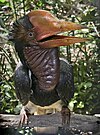
Borneo is the third largest island in the world. In prehistoric times it was connected to the Asian mainland due to geological and climate changes. During the recent ice ages of the Pleistocene and the Holocene separation from the mainland caused extinctions and speciation of fauna on the island.
Contents
- Invertebrates
- Vertebrates
- Fish
- Amphibians
- Reptiles
- Birds
- Mammals
- Impact of deforestation on fauna
- See also
- References
- External links
The high complexity of the Bornean tropical rain forest has created many niches that accommodate a rich diversity of fauna. Some fauna are specialised and some coexisted by having niche separation to avoid inter- and intra-specific competition within the same habitat. Ecological separation can be in the form of different feeding guilds, niche separation by stratification and different utilisation strategies by being diurnal or nocturnal. For example, vertebrate fauna (birds and mammals) can be defined into six communities based on vertical stratification of the rainforest. First, the small mammals and birds use the forest ground floor and underground. Second, the large herbivores and carnivorous animals range the ground floor of the forest searching for food, shelter and breed. Third, omnivorous and carnivorous mammals range up and down tree trunk from forest floor to the canopy level. Fourth, are mainly volant mammals such as bats and birds using the middle canopy. Fifth, are top canopy birds and mammals that feed on leaves, fruits, nectar and insects. Sixth, are the fast flying birds and bats using the above canopy area.




